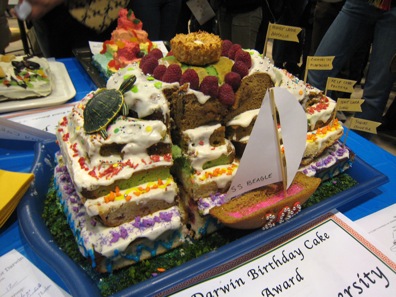ON KINGDOMS AND THE GALAPAGOS ISLANDS: A TREATISE ON DARWIN’S CONTRIBUTIONS TO MODERN ECOLOGY AND EVOLUTION IN CAKE FORM
We present a cake with layers representing the five Kingdoms according to Whittaker (1969; Animalia, Plantae, Fungi, Protista, and Monera; Figure 1). The cake is shaped as a pyramid embodying the dynamic and complex trophic interactions within ecosystems and also symbolizing to the volcanic Galapagos Islands where Darwin travelled and developed his evolutionary and ecological theories (Darwin, 1859; in particular the volcano Mt. Darwin). Also on the cake (Figure 2) you will find: Darwin’s boat the SS Beagle, a nest, egg and finch representing Darwin’s theory of Natural Selection, Gus the Giant Tortoise, and fissures in the cake layers signifying plate tectonics and Darwin’s interest in geography.
Cake recipes include:
Monera – probiotic yogurt cake
Protista – green kelp diatom cake
Fungi – polish yeast cake
Plantae – zucchini cake
Animalia – honey cake
Genetically modified icing, coconut finch nest, Japanese white chocolate almond ptarmigan egg and spinach seaweed


R. H. Whittaker (1969). “New concepts of kingdoms of organisms”. Science 163: 150–160. link
Darwin, Charles Robert (1859). On the Origin of Species by means of Natural Selection or the preservation of favoured races in the struggle for life. John Murray: London, England.
Charlotte Adamson1,3, Alaine F. Camfield 1, Amanda B. Edworthy 1, Meagan M. Grabowski 1, Michaela Martin 1, Isla H. Myers-Smith 1,2, Andrea R. Norris 1, Natalie L. Stafl 1, Kathy Martin 1
1. Martin Lab, Faculty of Forestry, Department of Forest Sciences, University of British Columbia
2. Department of Biological Sciences, University of Alberta
3. Department of Biology, Simon Fraser University